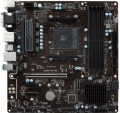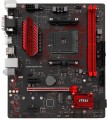Features
The general specialization of the motherboard is the type of tasks for which it is optimized. It should be noted that the division according to this indicator is often rather conditional, models similar in characteristics may belong to different categories. However, the data on specialization greatly simplifies the choice.
In addition to the traditional "motherboards"
for home and office, nowadays you can find solutions
for high-end PCs (High-End Desktop) and
for servers, as well as
gaming boards and models
for overclocking(the last two options are sometimes combined into one category , however, these are still different types of motherboards). There are also specialized models
for cryptocurrency mining, but very few of them are produced — especially since many boards that originally had a different purpose are suitable for mining (see "Suitable for mining").
Here is a more detailed description of each variety:
— For home and office. Motherboards that do not belong to any of the more specific types. In general, this kind of "motherboards" is very diverse, it includes options from low-cost motherboards for modest office PCs to advanced models that come close to gaming and HEDT solutions. However, for the most part, solutions from this category
...are designed for simple everyday tasks: working with documents, web surfing, 2D design and layout, games in low and medium quality, etc.
— Gamer's. Boards originally designed for use in advanced gaming PCs. In addition to high performance and compatibility with powerful components, primarily video cards (often several at once, in SLI and/or Crossfire format — see below), such models usually also have specific features of a gaming nature. The most noticeable of these features is the characteristic design, sometimes with backlighting and even backlight synchronization (see below), which allows you to organically fit the board into the original design of the gaming station. The functionality of gaming boards may include an advanced audio chip, a high-end network controller to reduce lags in online games, built-in software tools for tuning and optimizing performance, etc. Also, such models may provide advanced overclocking capabilities, sometimes not inferior to the capabilities of specialized boards for overclocking (see below). And sometimes the border between gaming and overclocking solutions is generally erased: for example, individual boards positioned by the manufacturer as gaming ones, in terms of functionality, can more likely be related to overclocking models.
— For overclocking. High-performance boards with an extended set of overclocking tools — improving system performance by fine-tuning individual components (mainly by increasing the clock frequencies used by these components). On most conventional motherboards, this setup involves considerable complexity and risk, it is usually an undocumented feature and is not covered by the warranty. However, in this case, the situation is the opposite: boards "for overclocking" are called so because the possibility of overclocking was originally incorporated in them by the manufacturer. One of the most noticeable features of such models is the presence in the firmware (BIOS) of special software tools for overclocking management, which makes overclocking as safe as possible and affordable even for inexperienced users. Another feature is improved compatibility with built-in overclocking tools provided in advanced processors, RAM modules, etc. Anyway, this particular type of board will be the best choice for those who want to build a fairly powerful PC with the ability to experiment in terms of performance.
— HEDT (High End Desktop). Motherboards designed for high-performance workstations and other PCs of a similar level. In many ways, they are similar to gaming ones and are sometimes even positioned as gaming ones, but they are designed more for general performance (including in professional tasks) than for confident work with games. One of the key features of such "motherboards" is the extensive functionality for working with RAM: they provide at least 4 slots for "RAM", and more often 6 or more, the maximum RAM frequency is at least 2500 MHz (and more often 4000 MHz and higher ), and the maximum volume is at least 128 GB. The rest of the characteristics are usually at a similar level. Also, the firmware may provide tools for overclocking, although in terms of this functionality, such boards are most often still inferior to overclockers. Note that such solutions can initially be positioned as gaming; the basis for categorization in the HEDT category in such cases is the fulfillment of the above criteria.
— For the server. Motherboards specially designed for servers. Such systems are noticeably different from conventional desktop PCs — in particular, they work with large volumes of drives and have increased requirements for the speed and reliability of data transfer; accordingly, to build servers, it is best to use specialized components, including motherboards. Among the main features of such motherboards are an abundance of slots for RAM (often more than 4), the ability to connect numerous drives (necessarily more than 4 SATA 3 slots, often 8 or more), as well as support for special technologies (like ECC — see below) . In addition, such boards can be made in specific form factors such as EEB or CEB (see "Form Factor"), although more traditional options are also found.
— Designed for mining. Motherboards specially designed for cryptocurrency mining (BitCoin, Ethereum, etc.). We emphasize that we are not just talking about the possibility of such an application (see “Suitable for mining”), but that the motherboard is initially positioned as a solution for creating a cryptocurrency “farm”. Recall that mining is the extraction of cryptocurrency by performing special calculations; such calculations are most conveniently carried out using several high-performance video cards at once. Accordingly, one of the distinguishing features of mining boards is the presence of several (usually at least 4) PCI-E 16x slots for connecting such video cards. However, this category of “motherboards” has not received much distribution: similar characteristics are also found among more general-purpose boards, it is quite possible to achieve performance sufficient for efficient mining on them.LED lighting
The presence of its own LED
backlight on the motherboard. This feature does not affect the functionality of the "motherboard", but gives it an unusual appearance. Therefore, it hardly makes sense for an ordinary user to specifically look for such a model (a
motherboard without backlighting is enough for him), but for modding lovers, backlighting can be very useful.
LED backlighting can take the form of individual lights or LED strips, come in different colours (sometimes with a choice of colours) and support additional effects — flashing, flickering, synchronization with other components (see "Lightning synchronization"), etc. Specific features depend on the motherboard model.
Lighting sync
Synchronization technology provided in the board with LED backlight (see above).
Synchronization itself allows you to "match" the backlight of the motherboard with the backlight of other system components — cases, video cards, keyboards, mice, etc. Thanks to this matching, all components can change colour synchronously, turn on / off at the same time, etc. Specific features the operation of such backlighting depends on the synchronization technology used, and, usually, each manufacturer has its own (Mystic Light Sync for MSI, RGB Fusion for Gigabyte, etc.). The compatibility of the components also depends on this: they must all support the same technology. So the easiest way to achieve backlight compatibility is to collect components from the same manufacturer.
Size (HxW)
Motherboard dimensions in height and width. It is assumed that the traditional placement of motherboards is vertical, so in this case one of the dimensions is called not the length, but the height.
Motherboard sizes are largely determined by their form factors (see above), however, the size of a particular motherboard may differ slightly from the standard adopted for this form factor. In addition, it is usually easier to clarify the dimensions according to the characteristics of a particular motherboard than to look for or remember general information on the form factor. Therefore, size data can be given even for models that fully comply with the standard.
The third dimension — thickness — is considered less important for a number of reasons, so it is often omitted.
DDR4
The number of slots for DDR4 memory sticks provided in the motherboard.
DDR4 is a further (after the third version) development of the DDR standard, released in 2014. Improvements compared to DDR3 are traditional — an increase in operating speed and a decrease in power consumption; The volume of one module can be from 2 to 128 GB. It is this RAM standard that most modern motherboards are designed for; the number of slots for DDR4 is usually
2 or
4, less often —
6 or more.
Max. memory
The maximum amount of RAM that can be installed on the motherboard.
When choosing according to this parameter, it is important to take into account the planned use of the PC and the real needs of the user. So, volumes
up to 32 GB inclusive are quite enough to solve any basic problems and run games comfortably, but without a significant reserve for an upgrade.
64 GB is the optimal option for many professional use cases, and for the most resource-intensive tasks like 3D rendering,
96 GB or even
128 GB of memory will not be a limit. The most “capacious” motherboards are compatible with volumes of
192 GB or
more - they are mainly top-end solutions for servers and HEDT (see “In the direction”).
You can choose this parameter with a reserve – taking into account a potential RAM upgrade, because installing additional RAM sticks is the simplest way to increase system performance. Taking this factor into account, many relatively simple motherboards support very significant amounts of RAM.
Steel PCI-E connectors
The presence of reinforced
steel PCI-E connectors on the "motherboard".
Such connectors are found mainly in gaming (see "In the direction") and other advanced varieties of motherboards, designed to use powerful graphics adapters. Steel slots are usually made PCI-E 16x, just designed for such video cards; in addition to the slot itself, its attachment to the board also has a reinforced design.
This feature offers two key advantages over traditional plastic connectors. Firstly, it allows you to install even large and heavy video cards as reliably as possible, without the risk of damaging the slot or board. Secondly, the metal connector plays the role of a protective screen and reduces the likelihood of interference; this is especially useful when using multiple video cards installed side by side.
Audiochip
The model of the audio chip (a module for processing and outputting sound) installed on the motherboard. Data on the exact name of the sound chip will be useful when looking for detailed information about it.
Modern "motherboards" can be equipped with fairly advanced audio modules, with high sound quality and extensive features, which makes them suitable even for gaming and multimedia PCs (although professional audio work will still most likely require a separate sound card). Here are the most popular modern audio chips:
Realtek ALC887,
Realtek ALC892,
Realtek ALC1150,
Realtek ALC1200,
Realtek ALC1220,
Realtek ALC4050,
Realtek ALC4080,
Supreme FX.

